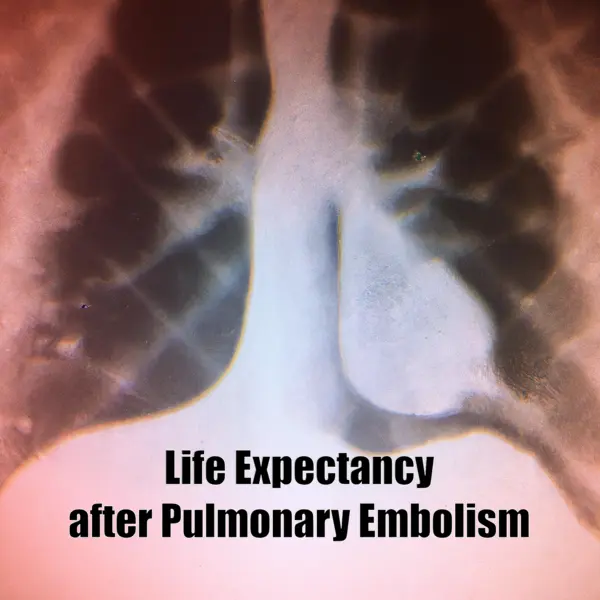Pulmonary embolism (PE) is a serious condition that can be deadly. It occurs when a clot, usually originating from the deep veins in the legs, travels through the blood vessels and blocks one of the arteries in the lungs. This obstruction limits the blood flow to the lungs, causing a decrease in oxygen levels and placing additional strain on the heart.
The primary cause of pulmonary embolism is deep vein thrombosis (DVT), which happens when a clot develops in one of the deep veins, often in the lower limbs. When a clot breaks away from DVT and moves to the lungs, it leads to a pulmonary embolism.
Life Expectancy According to Statistics
Research on life expectancy after pulmonary embolism has shown promising results. Several studies have examined the long-term prognosis and survival rates of individuals who have experienced a pulmonary embolism. Here are some key findings and statistics:
A study published in the Journal of the American Medical Association found that the 5-year mortality rate after a pulmonary embolism was approximately 16%.
Another study published in the European Respiratory Journal found that the 10-year mortality rate after a pulmonary embolism was around 30%.
It is important to note that these statistics can vary depending on the individual’s overall health, the severity of the pulmonary embolism, and the effectiveness of treatment.
Factors Affecting Life Expectancy After Pulmonary Embolism
After going through a pulmonary embolism, there are various factors that can impact how long a person will live. It is crucial to take these factors into account when discussing the prognosis with healthcare providers. Here are three significant factors that can influence life expectancy following a pulmonary embolism:
Severity of the Condition
The seriousness of the pulmonary embolism has a notable impact on how long a person may live. When blood clots that are larger in size obstruct important arteries, they can cause more harm and elevate the chances of developing complications.
Underlying Health Conditions
Having pre-existing health conditions can affect the body’s ability to recover from a pulmonary embolism. Health problems like heart disease, cancer, and chronic lung disease can complicate the recovery process and potentially shorten life expectancy.
Age and Overall Health
Age and overall health also play a crucial role in determining life expectancy. Older adults and individuals with pre-existing health conditions may have a higher risk of complications and a lower life expectancy after a pulmonary embolism.
It is essential to discuss these factors with healthcare professionals to understand individual prognosis and receive appropriate care and support.
Risk Factors
There are several risk factors that increase the likelihood of developing a pulmonary embolism:
- Extended periods of being unable to move, such as sitting or lying down for a long time on long flights or while recovering from surgery, can heighten the likelihood of developing blood clots.
- Recent operations, particularly those that involve the lower limbs or abdomen, can heighten the chances of developing blood clots.
- Cancer: Certain forms of cancer as well as specific cancer therapies can heighten the chance of developing blood clots.
- Older age: The risk of pulmonary embolism increases with age.
- Being excessively heavy or having obesity can elevate the likelihood of developing blood clots.
- Smoking negatively impacts blood vessels and can raise the chances of developing blood clots.
- Some forms of hormone therapy, like taking birth control pills or undergoing hormone replacement therapy, may enhance the likelihood of developing blood clots.
Post-Treatment Care
After undergoing treatment for pulmonary embolism, it is essential to prioritize post-treatment care and follow a structured rehabilitation program to ensure a smooth recovery. Here are some key aspects of post-treatment care for individuals recovering from a pulmonary embolism:
- Medication Compliance: It is crucial to take any prescribed medications as directed by the healthcare provider. Blood thinners, such as anticoagulants, are commonly prescribed to prevent further blood clots from forming. Compliance with medication is essential to reduce the risk of recurrence.
- Follow-up Appointments: Regular follow-up appointments with the healthcare provider are necessary to monitor recovery progress and adjust treatment plans if needed. These appointments allow healthcare professionals to assess lung function, manage medication dosages, and monitor any potential complications or side effects.
- Physical Activity Gradual Increase: Engaging in physical activity is important for rehabilitation and preventing further health complications. However, it is crucial to start slow and gradually increase activity levels under the guidance of a healthcare professional. Physical therapy may be recommended to help regain strength and endurance.
- Lifestyle Modifications: Making lifestyle modifications can significantly contribute to recovery and reduce the risk of future health issues. This may include quitting smoking, maintaining a healthy weight, adopting a balanced diet, and managing chronic conditions, such as hypertension or diabetes.
- Emotional Support: Recovering from a pulmonary embolism can be physically and emotionally challenging. It is important to seek emotional support from loved ones, support groups, or mental health professionals to cope with any anxiety, depression, or post-traumatic stress that may arise during the recovery process.
By following these post-treatment care guidelines, individuals can optimize their recovery and reduce the risk of future complications after a pulmonary embolism. Remember, each person’s recovery journey is unique, and it’s essential to consult with a healthcare provider for personalized guidance and recommendations.
About the Author
Reyus Mammadli is the author of this health blog since 2008. With a background in medical and biotechnical devices, he has over 15 years of experience working with medical literature and expert guidelines from WHO, CDC, Mayo Clinic, and others. His goal is to present clear, accurate health information for everyday readers — not as a substitute for medical advice.







